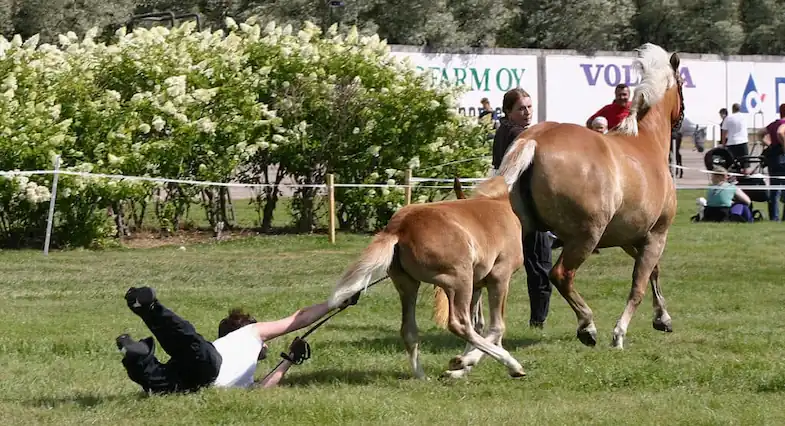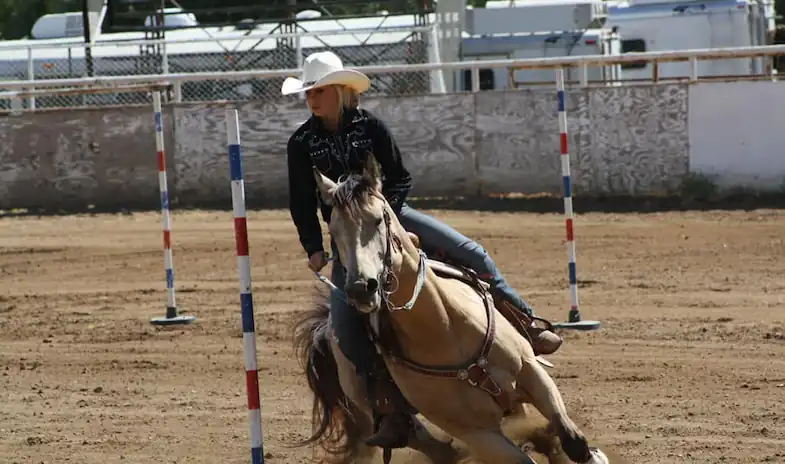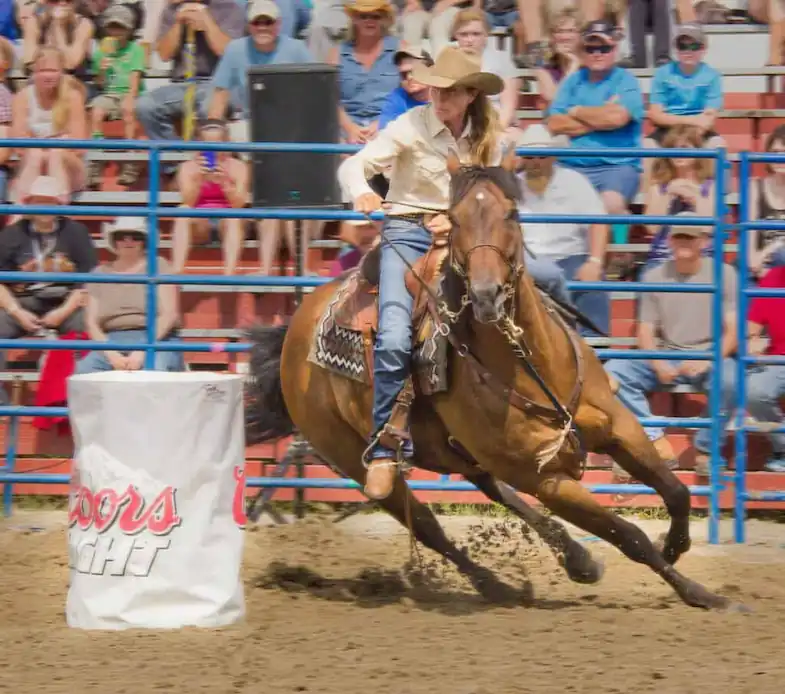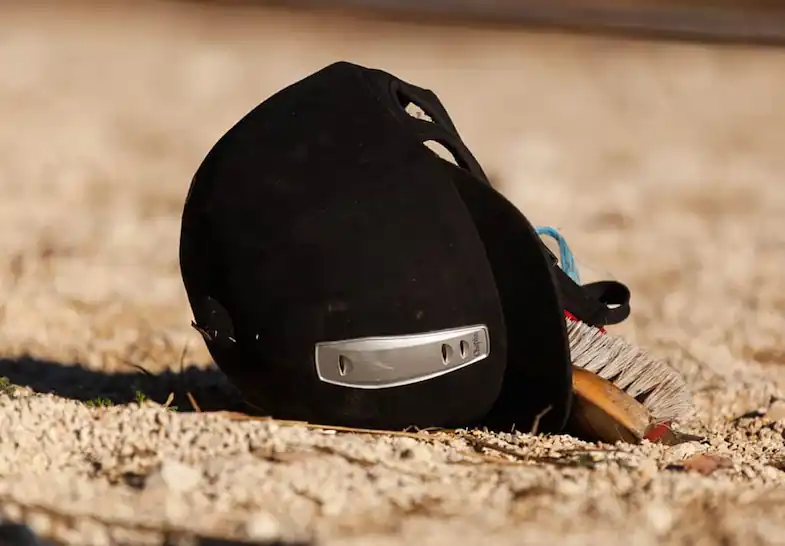When I was much younger (in fact I was still in high school) I injured myself skiing, but what really made me laugh was the yard owner’s reaction when I told her I wouldn’t be able to come to work for a few days because I needed to rest my leg. Her exact words were ‘well if you will do these dangerous sports what do you expect’! Now I know that skiing can be dangerous but surely most people would say that horse riding was more dangerous? This is something I’ve often wondered, just how dangerous horse riding really is?
Is horse riding really that dangerous? There will always be an element of danger in horse riding, after all, horses are living creatures with a mind of their own, but that doesn’t make the sport as a whole dangerous, or at least as dangerous as it’s perceived to be.
To some extent its impossible to measure how dangerous horse riding is with absolute certainty because while you can easily record the number of accidents and injured riders it’s not so easy to know how often they ride, how long they ride for, how many horses they ride or how long they’ve been riding for. While you might not think any of those will make a difference to how dangerous a sport is they do help to demonstrate how likely you are to suffer an injury yourself and therefore how risky a sport is. It’s for that reason that any risk assessment can only be an estimate.
How dangerous is horse riding?
The injuries sustained during horse riding accidents have been likened to those seen by participants of motor racing (both cars and bikes) and extreme sports such as helicopter skiing but this doesn’t really tell the whole story. Yes, horse riding is dangerous, after all even if you fall off a pony you’re still falling a long way, but what’s more important is how likely you are to seriously injure yourself. After all, if you have an accident jumping from a helicopter the chances of serious injury are far higher.
The vast majority of all horse riding accidents don’t require any hospital treatment but that doesn’t mean you should just ignore them though. A large number of these are soft tissue or musculoskeletal injuries which can, if not treated at the time, lead to long-term pain or disability which is why it’s important to have any injury (even if you think you’re unhurt) checked out.
While there’s no denying horse riding is a dangerous sport though it’s worth mentioning that around 75% of all horse-related accidents happen on the ground rather than in the saddle.
Are some disciplines more dangerous than others?
You might think that it doesn’t matter what type of horse riding you’re doing your chances of injury are the same but this isn’t the case. While you might not be surprised that sports such as eventing or barrel racing are the most dangerous you’ll probably be shocked to know that equestrian vaulting is one of the safest of all disciplines.
To some extent, it’s the speed of the discipline that decides not so much how dangerous it is but how bad any injuries might be. After all, if you’re an eventer and are racing full speed at a natural fixed object and your horse suddenly stops you’re going to hit the fence (or the ground) much harder than if the horse was just trotting up to the obstacle. With this in mind, I’ve listed the most dangerous disciplines below (with the most dangerous being at the top).
- Eventing
- Barrel racing
- Pole bending
- Trick riding
- Racing (all forms except barrel)
- Showjumping
- Polo
- Hunting
- Dressage
- Vaulting
What are the most common horse riding injuries?
When you consider that the vast majority of horse riding accidents happen when the rider ‘leaves’ the horse unintentionally it’s no wonder that head injuries are the most common of all riding injuries with one in five visits to the ER being for some sort of blow to the head. After head injuries, broken arms are the next most common.
Other injuries, while not so common, can include long term paralysis (typically due to spinal cord damage) and even death.
How common are fatal horse riding accidents?
Thankfully most horse riding accidents aren’t fatal, especially now that there’s an increased use in proper protective riding helmets but in the US alone there are around 100 horse riding-related deaths every year. That said though that’s just a number and it doesn’t really say much about how common they are, instead, I thought it would make more sense to compare them to a number of other causes of fatalities.
| Deaths per year* | |
| Guns | 39,000 |
| Road traffic accidents | 38,800 |
| Accidents around the home | 30,000 |
| Knifes | 1,500 |
| Hypothermia | 700 |
| Horse riding accidents | 100 |
| Hornets / Bees / Wasps | 50 |
| Dog attacks | 48 |
| Snake bites | 5 |
| Grizzly bear attacks | 2 |
| Mountain lion attacks | 0.24 |
Is horse riding the most dangerous sport?
Every list of dangerous sports will place horse riding somewhere in the top 15 if not the top 10 but the problem with this is that it doesn’t take the number of participants into account. They record the number of injuries and nothing else which can often alter the results, after all, if two people play tiddlywinks and one of them hurts themselves then recording just that will make the sport seem very safe, but if you record the percentage of injuries then at 50% tiddlywinks would have to be the most dangerous sport in the world! Don’t worry though if you play tiddlywinks properly it’s not dangerous at all!
The trouble with recording the percentage of injuries though is that not all sports record the number of participants, especially if the sport is open to everybody, everywhere, and at any time. With this in mind, I’ve used data from insurance claims to work out which sports are most likely to result in serious injury.
- Motor Racing
- Horse Riding
- Cheerleading
- Gymnastics
- BASE jumping
- Bull Riding
- Cycling
- Boxing
- American Football
- Soccer
What can you do to reduce your chance of injury?
It’s important to remember that horses are flight animals that can be unpredictable when they’re frightened, even if we think we know them they can still surprise us and catch us off guard which is why you should always be prepared and behave accordingly around horses. Think about your actions and what you’re doing, if your horse dislikes sudden noises set your phone to silent while you’re out riding.
Making sure your horse’s tack is in good condition can go some way to reducing the severity of a fall, as can wearing the correct protective equipment. While you might not be keen on wearing a riding helmet it can not only save your life but also drastically diminish your chances of serious injury. A body protector and properly fitting riding boots can also lessen any injury (especially back injuries in the case of body protectors).
Conclusion
I think we can safely say that yes horse riding is dangerous but at the same time, it’s great fun, and I’m sure the vast majority of us would agree that the joy it brings outweighs the danger it poses. On top of that, we can do things, like wearing protective gear, to reduce our chances of injury. And anyway, just stepping outside of your front door can be dangerous so it’s better to be aware of the risks but continue riding – at least that’s what I do!
Further reading
- Learn to ride in 12 easy steps
- How to be a better rider
- Getting back into riding again
- How Western & English differ
- Top Western disciplines
- Do you really need spurs?
- Guide to the best gloves
- Equestrian vaulting
I hope you found this article helpful. If you did I’d be grateful if you could share it please as it would really help me.
Recommended products
Over the years I have tried hundreds of different horsey products, from various blankets and halters to different treats. Some I’ve loved, others I’ve hated but I thought I’d share with you my top all-time favorite products, the ones I never leave the yard without. I’ve included links to the products (which are in no particular order) that I really think are great.
- Horse Knots by Reference Ready – If you’re like me and enjoy pocket reference guides then you’ll love this knot tying guide. These handy cards can easily fit in your pocket or attach to the saddle for quick reference. They’re waterproof, durable and are color coded to make them easy to follow.
- Mane ’n Tail Detangler – Even if you never show your horse you’ll need to detangle his tail from time to time (and possibly his mane too) which is always a challenging chore! I’ve found that if I run a little bit of detangler through my horse’s tails every few days it stops them from getting matted up and makes combing them easy, even if they’re coated in mud. I don’t know if I should admit to this or not but it also works wonders on my hair.
- TAKEKIT Pro clippers – Over the years I’ve tried a lot of different clippers and while some were obviously better than others I found these to be by far the best. They are heavier than a lot of other clippers but for me, that’s a good thing, it makes them feel more sturdy and hardwearing. On top of that they have a range of speeds so are just as good for clipping your horse’s back as they are his face. I also like the fact that they come in a handy carry case but that’s not for everybody. The company that makes them is super good and incredibly helpful too, a real bonus these days. The only thing I wasn’t keen on was the fact that it doesn’t come with any oil, but that’s not a major problem as it’s not difficult to buy lubricant.
- Shire’s ball feeder – There are so many boredom buster toys out there but I like to use these every day, regardless of whether or not my horses are bored. I find that it helps to encourage my horses to problem solve by rewarding them with treats (or pieces of fruit) but it also mimics their natural grazing behavior which helps to keep them calm and de-stressed.
- Horse safe mirror – This is a strange one that many people are surprised about but I like to put horse safe mirrors in the trailers as well as in the quarantine stalls. It helps to prevent the feeling of isolation by giving the impression of other horses being around. Being herd animals horses can get extremely stressed when they feel that they’re on their own but with these stick-on mirrors, they believe that at least one other horse is with them.
- Rectal thermometer – I know this isn’t glamourous at all but it’s vital for your horse’s well-being to be able to check their temperature and a rectal thermometer is the easiest way of doing this which is why I’ve added it to the list.
Shopping lists
I’ve also put together a few shopping lists of essential items that I’ve found helpful over the years. I’ve broken the lists down into different categories rather than put everything in one massive list 😉





